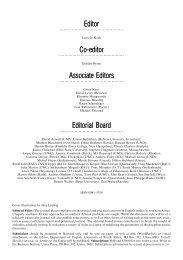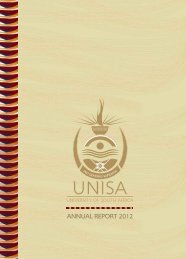pdf: 6.426kb - University of South Africa
pdf: 6.426kb - University of South Africa
pdf: 6.426kb - University of South Africa
You also want an ePaper? Increase the reach of your titles
YUMPU automatically turns print PDFs into web optimized ePapers that Google loves.
shaman's way <strong>of</strong> life, coupled with an attempt to<br />
give a description based on personal participation.<br />
3. The ethnologist must seriously acknowledge the<br />
mental techniques and experiences <strong>of</strong> the shaman<br />
and should himself experiment with some <strong>of</strong><br />
them. (Some researchers, such as V. Brown,<br />
Boyd, Cushing, David-Neel, Eaton, Katz, Kunze,<br />
J. R. Walker, and others, either have taken<br />
psychoactive drugs, fasted, and prayed or have<br />
gone in search <strong>of</strong> visions. In this way they have,<br />
to a certain extent, acquired an inner understanding<br />
<strong>of</strong> the shaman's way <strong>of</strong> life.)<br />
4. The ethnologist becomes an apprentice <strong>of</strong> the<br />
shaman, thereby transcending his traditional role<br />
as a scientist, raising his scientific curiosity to a<br />
new and higher level, and attempting to combine<br />
learning with active reflection. (By now, a<br />
number <strong>of</strong> Westerners have entered into or<br />
partially completed such an apprenticeship, as<br />
for instance Boshier, Co rdova-Rios, Derlon,<br />
Harner, and Prem Das.)<br />
The most complete description <strong>of</strong> and the deepest<br />
insight into the life <strong>of</strong> the shaman will, <strong>of</strong> course,<br />
come from researchers who themselves enter into<br />
altered states <strong>of</strong> consciousness. The more we manage<br />
to close the gap between the scientist and the<br />
shaman, the closer we come to a truly transpersonal<br />
and transcultural science (Kalweit 1988:246).<br />
Ethnology resists a strictly psychological analysis <strong>of</strong><br />
shamanism Ð and rightly so, because it is undeniable<br />
that our Western psychology has been ethnocentric<br />
from it's very beginnings and has always refused to<br />
accord any kind <strong>of</strong> recognition to tribal psychologies<br />
and philosophies. Transpersonal science, on the other<br />
hand, has come into being from a fusion <strong>of</strong> Asian<br />
philosophy and Western consciousness research, just<br />
as transpersonal anthropology also takes account <strong>of</strong><br />
the wisdom and systems <strong>of</strong> knowledge <strong>of</strong> other<br />
cultures. It is this kind <strong>of</strong> transcultural science that<br />
can bridge the gap between traditional and modern<br />
societies; it may be symbiotic, combining the energies<br />
<strong>of</strong> several ways <strong>of</strong> life, but it is stimulating a new<br />
universal science <strong>of</strong> man. Soon transcultural science<br />
will overtake the kind <strong>of</strong> narrow-minded research into<br />
shamanism, which considers the shaman as no more<br />
than an object and product <strong>of</strong> social circumstances<br />
(Kalweit 1988:247).<br />
In an age characterized by an unshakeable faith in<br />
science it has become the task <strong>of</strong> anthropology to<br />
provide a rational explanation for such wayward and<br />
illogical notions and concepts (Kalweit 1988:xii). The<br />
shaman should therefore not be branded as some sort<br />
<strong>of</strong> archaic hero or as a relic <strong>of</strong> the past, who, although<br />
historically redundant, somehow continues to vegetate<br />
on the fringe <strong>of</strong> our technological civilization. In<br />
the light <strong>of</strong> the revolutionary findings <strong>of</strong> recent<br />
researchers into the nature <strong>of</strong> dying and death, the<br />
shaman should be considered as a most up-to-date<br />
and knowledgeable psychologist (Kalweit 1988:13).<br />
In order to gain more knowledge <strong>of</strong> the world view<br />
and <strong>of</strong> the origin <strong>of</strong> the knowledge which the<br />
vegetalista possesses and which he believes he<br />
obtains, in altered states <strong>of</strong> consciousness, while<br />
under the influence <strong>of</strong> ayahuasca, transpersonal<br />
research will form an important aspect <strong>of</strong> my fieldwork.<br />
THE PERUVIAN AMAZON<br />
Peru, a country <strong>of</strong> 1 285 215 Km, has 54 per cent <strong>of</strong> its<br />
territory in the Amazon area. This area is located<br />
within a larger geographical unity, the Upper Amazon<br />
Basin, which comprises the network <strong>of</strong> rivers that<br />
drain the tropical rainforest east <strong>of</strong> the Andes<br />
mountains and flow into the Amazon River until the<br />
mouth <strong>of</strong> the Rio Madeira (Lathrap 1970:22±23).<br />
There is a geographical and ecological differentiation<br />
between the forest on the steep eastern slopes <strong>of</strong><br />
the Andes, between 400 and 1000 metres above sea<br />
level, with heavy rainfall, and a great contrast in the<br />
temperatures between day and night (between 148<br />
and 328 Centigrade), and the tropical forest on the<br />
floor <strong>of</strong> the Amazon Basin, situated between 80 and<br />
400 metres above sea level, with hot temperatures<br />
(between 248 and 408 Centigrade), high humidity and<br />
<strong>of</strong>ten violent rains (Rumrill 1984:33).<br />
Four departments <strong>of</strong> Peru (Loreto, San MartõÂn,<br />
Ucayali, and Madre de Dios) lie completely within the<br />
Amazon area, while eleven other departments have<br />
part <strong>of</strong> their territories covered by tropical rain forest<br />
(Luna 1986:25).<br />
Numerous Indian communities belonging to various<br />
linguistic families, lived Ð and several still live Ð in<br />
this area (Luna 1986:25). Lowie (1948:1) points out<br />
that their cultural complex contrasts markedly from<br />
that <strong>of</strong> the Andean civilizations by lacking architectural<br />
and metallurgical refinements. Their diagnostic<br />
features are the cultivation <strong>of</strong> tropical root crops, the<br />
construction <strong>of</strong> effective wooden river craft, the use <strong>of</strong><br />
hammocks as beds, and the manufacture <strong>of</strong> simple<br />
pottery.<br />
According to the same author, a second feature,<br />
namely the effective use <strong>of</strong> canoeing, allowed certain<br />
tribes to spread their art and customs over enormous<br />
distances, and this, combined with natural conditions,<br />
produced the remarkable levelling <strong>of</strong> culture in this<br />
area. Other factors, such as the generalized custom <strong>of</strong><br />
taking a bride from another settlement, irrespective <strong>of</strong><br />
linguistic affinity (Lowie 1948:29), and the necessity<br />
<strong>of</strong> trading among distant tribes or villages for the<br />
purpose <strong>of</strong> obtaining essential raw materials (Latharp<br />
1970:32) contributed to this levelling <strong>of</strong> culture. We<br />
may even say that syncretism was thus built into the<br />
system (Luna 1986:26).<br />
ISSN 0256±6060±Unisa Lat. Am. Rep. 16(2) 2000 45

















